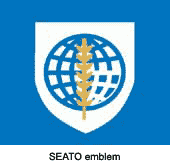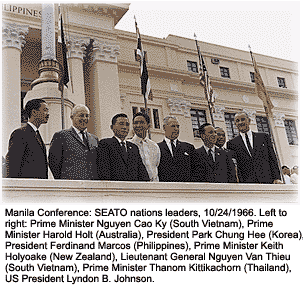Overview
The Southeast Asia Treaty Organization (SEATO), whose principal architect was Secretary of State John Foster Dulles, was created in 1954 to stem further communist takeover of countries in the Pacific region. SEATO also was established to
legitimize the United States' presence in South Vietnam to fight the communist movement under nationalist Ho Chi Minh of North Vietnam.
 Representatives from Australia, France, Great Britain, New Zealand, Pakistan, the Philippines, Thailand, and the United States, under the Southeast Asia Collective Defense Treaty, (from which SEATO was formed), pledged to defend against what it saw as an escalation of communist military aggression against democracy. Headquartered in Bangkok, Thailand, SEATO functioned by unanimous vote only, which was the ultimate cause of its dissolution in 1977.
Representatives from Australia, France, Great Britain, New Zealand, Pakistan, the Philippines, Thailand, and the United States, under the Southeast Asia Collective Defense Treaty, (from which SEATO was formed), pledged to defend against what it saw as an escalation of communist military aggression against democracy. Headquartered in Bangkok, Thailand, SEATO functioned by unanimous vote only, which was the ultimate cause of its dissolution in 1977.
What follows is an illustration of U.S. foreign policy in relation to SEATO during the country's involvement in Vietnam:
Cambodia - 1955
“U.S. Secretary of State John Foster Dulles and his brother, CIA Director Allen Dulles, each visited me [Cambodian King Norodom Sihanouk], and attempted to persuade me to place Cambodia under the protection of SEATO. I kindly declined the offer, preferring to adopt a neutral stance in the conflict between our neighbors and the U.S. I considered SEATO an aggressive military alliance directed against neighbors whose ideology I did not share but with whom Cambodia had no quarrel. I had made all this quite clear to John Foster, an acidy, arrogant man, but his brother soon turned up with a briefcase full of documents ‘proving’ that Cambodia was about to fall victim to ‘communist aggression’ and that the only way to save the country, the monarchy and myself was to accept the protection of SEATO. The ‘proofs’ did not coincide with my own information, and I replied to Allen Dulles as I had replied to John Foster: Cambodia wanted no part of SEATO. We would look after ourselves as neutrals and Buddhists. There was nothing for the secret service chief to do but pack up his dubious documents and leave.”- Cambodian King Norodom Sihanouk
 “Operation Breakfast”
“Operation Breakfast”
Operation Breakfast was a secret campaign proposed by Henry Kissinger, President Richard M. Nixon's assistant for National Security Affairs. Kissinger convinced the president that he should begin a bombing campaign in Cambodia where Vietcong and North Vietnamese had established logistical bases. The secret campaign spurred the Vietnamese to move deeper into Cambodia, which caused U.S. bombing to move farther into the country's interior as well. As in Laos, the U.S. dropped a huge number of bombs on civilian areas. Craig Etcheson would later write in his book, The Rise and Demise of Democratic Kampuchea (Cambodia), “The fact is that the United States dropped three times the quantity of explosives on Cambodia between 1970 and 1973 than it had dropped on Japan for the duration of World War II."
Cambodia – 1975
While Cambodian king Norodom Sihanouk was on a trip abroad, his top ministers, Lon Nol and Sirik Matak, usurped control of the country and immediately began to cooperate with the United States military to expel the North Vietnamese and Vietcong presence in Cambodia. The Khmer Rouge, under the leadership of Pol Pot and supported by a population terrorized by the U.S. bombing campaign, waged guerrilla warfare against the new government, overthrowing it in 1975. In 1993, U.N.-administered elections led to a new constitution and the reinstatement of Norodom Sihanouk as king of Cambodia.